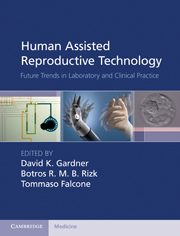
-
Select format
-
- Publisher:
- Cambridge University Press
- Publication date:
- May 2011
- March 2011
- ISBN:
- 9780511734755
- 9781107001121
- Dimensions:
- (246 x 189 mm)
- Weight & Pages:
- 0.94kg, 250 Pages
- Dimensions:
- Weight & Pages:
You may already have access via personal or institutional login
Book description
Human Assisted Reproductive Technology: Future Trends in Laboratory and Clinical Practice offers a collection of concise, practical review articles on cutting-edge topics within reproductive medicine. Each article presents a balanced view of clinically relevant information and looks ahead to how practice will change over the next five years. The clinical section discusses advances in reproductive surgery and current use of robotic surgery for tubal reversal and removal of fibroids. It looks into the refinement of surgical procedures for fertility preservation purposes. Chapters also discuss non-invasive diagnosis of endometriosis with proteomics technology, new concepts in ovarian stimulation and in the management of polycystic ovary syndrome, and evidence-based ART. The embryology section discusses issues ranging from three-dimensional in-vitro ovarian follicle culture, and morphometric and proteomics analysis of embryos, to oocyte and embryo cyropreservation. This forward-looking volume of review articles is key reading for reproductive medicine physicians, gynecologists, reproductive endocrinologists, urologists and andrologists.
Reviews
'… educational, well written and comprehensive …'
Source: Acta Obstetricia et Gynecologica Scandinavica
Contents
Metrics
Altmetric attention score
Full text views
Full text views help Loading metrics...
Loading metrics...
* Views captured on Cambridge Core between #date#. This data will be updated every 24 hours.
Usage data cannot currently be displayed.
Accessibility standard: Unknown
Why this information is here
This section outlines the accessibility features of this content - including support for screen readers, full keyboard navigation and high-contrast display options. This may not be relevant for you.
Accessibility Information
Accessibility compliance for the PDF of this book is currently unknown and may be updated in the future.


